Research Article Open Access
Effects of Insect Mass Outbreaks on Throughfall Composition in Even Aged European Pine Stands - Implications for the C and N Cycling
| Anne le Mellec1*, Jerzy Karg2, Zdzislaw Bernacki2, Jolanta Slowik3, Ignaczy Korczynski4, Timo Krummel1, Andrzej Mazur4, Holger Vogt-Altena1, Gerhard Gerold1 and Annett Reinhardt1 | |
| 1University of Goettingen, Landscape Ecology Section, Goldschmidtstr. 5, D-37077 Goettingen, Germany | |
| 2Research Centre for Agricultural and Forest Environment, Polish Academy of Sciences, Field Station Turew, Szkolna 4, Pl-4-000 Kościan, Poland | |
| 3University of Goettingen, Centre for Nature Conservation (CNC), von Sieboldstrasse 2, D-7075 Goettingen, Germany | |
| 4Poznan University of Life Sciences, Department of Forest Entomology, Ul. Wojska Polskiego 71c, PL-60-637 Poznan, Poland | |
| Corresponding Author : | Anne le Mellec University of Goettingen Landscape Ecology Section Goldschmidtstr. 5, D-37077 Goettingen, Germany Tel: (+49) 0551-3912134; E-mail: amellec@gwdg.de |
| Received November 12, 2010; Accepted December 22, 2010; Published December 24, 2010 | |
| Citation: le Mellec A, Karg J, Bernacki Z, Slowik J, Korczynski I, et al. (2010) Effects of Insect Mass Outbreaks on Throughfall Composition in Even Aged European Pine Stands - Implications for the C and N Cycling. J Earth Sci Climat Change 1:101. doi: 10.4172/2157-7617.1000101 | |
| Copyright: © 2010 le Mellec A, et al. This is an open-access article distributed under the terms of the Creative Commons Attribution License, which permits unrestricted use, distribution, and reproduction in any medium, provided the original author and source are credited. | |
Visit for more related articles at Journal of Earth Science & Climatic Change
Abstract
In this paper we report on the herbivore-affected C and N concentrations in the throughfall and altered canopy to soil transfer during a Pine Lappet (Dendrolimus pini L) mass infestation in 60-year-old Scots Pine (Pinus sylvestris L) forests. Our investigations covered a period of 7 months and could show, that herbivore defoliation significantly altered C and N concentrations in the throughfall solution and enhanced organic matter input situation to the forest floor. Compared to the uninfested site mean concentrations of the throughfall solution at the infested site under strong frass activity contained 80% more C and 61% more N. Additionally, C and N inputs were with 131 kg C ha-1 time-1 and 9.6 kg N ha-1 time-1 higher under strong frass activity during 3 months compared to the input at the uninfested site. We assume that outbreaks of phytophagous insects play an important key role in monoculture forest by influencing the nutrient turnover.
| Keywords |
| Forest disturbances; Climate Change; Insect mass outbreaks |
| Introduction |
| The decline in summer precipitation and increase of frequency and duration of summer droughts of various regions in Central Europe will affect the current tree species composition of forest systems to a great extend [1,2,3]. With respect to aside from a drop in net primary production (NPP) [4], the subsequent diminishing C storage in wood biomass and alterations in carbon cycling characteristics [5] will have fatal consequences for the overall stability of forest stands resulting in a lowered adaptability and resilience of forest ecosystems [6]. In this context it is important to point out that selection pressure will not only be directed by the abiotic factors alone. According to the latest IPCC assessment report, disturbances in the form of insect infestations will most certainly increase in European areas featuring sub-continental to continental climatic conditions as the result of a decline in precipitation amounts and rising temperatures, depending on the prognostic warming scenario [7]. |
| The changing climate in Central Europe will play a vital role in the host tree – pest relationship. Studies have shown that especially the climatic conditions greatly affect the development of the pest and pathogens [8-11] As a consequence of the predicted increase of pest mass outbreaks many forest stands will most certainly turn into risk stands which are characterized by an increase of the intensity and magnitude of the occurrence of mass outbreaks [12,13]. |
| Outbreaks of phytophagous insects are a phenomenon, which is often associated with a low structural- and species diversity, advantageous climatic conditions and a low resistance of forests which cause heavy damages by frass activities [14-17]. For one thing such forest disturbances are considered as an important functional factor within natural forest dynamics [18-20]. From the long-term perspective of a forest ecosystem, insect herbivore can act as a regulator of forest primary production, leading to increasing above ground biodiversity after defoliation [21-23]. It is suggested, that herbivore insect feeding activities can increase light penetration through the foliage canopy, reduce competition among plants, increase input rate of fall of Nutrient Rich litter, stimulate the redistribution of nutrient within plants, as well as the decomposition activity. The view of that fact that herbivore insects likely contribute to increase nutrient availability and subsequent productivity, it became inappropriately linked with the “herbivores as mutualists” hypothesis, in which herbivores are seen to increase the fitness of plants upon which they feed [24-26]. |
| For another thing mass outbreaks are known to cause severe economic damages [17,20] with a high occurrence in even age and single species managed forests. |
| In the northeastern part of Germany and Poland large areas were afforested by monocultured Scots Pine forests (Pinus silvestris) after war and after forest fire situations. In the past large areas were defoliated by some of the most dangerous pine pests in Europe and do so in recent time. The impacts that mass outbreaks of insects can have on forest ecosystems functioning are distinct and vary between indirect and direct effects [26]. Due to their defoliating activity pests reveal as large influencing phenomenon on element cycling due to their production and transformation of organic matter that enters the soil system by throughfall and dry insect pellets and greenfall fragments. |
| On account of its ecologically and economically salient characteristics, the Scots Pine (Pinus sylvestris) is considered as one of the most valuable tree species in Germany and Poland. This reputation is based on this tree species´ ecological adaptability, the relatively low demand concerning site conditions (water, nutrients), the rapid growth rates and the fairly short rotation periods (i.e. availability for timber markets) [27,28]. Representing almost 26% of the overall forested area, the Scots Pine is rated as the second most prevalent tree species in Germany. |
| The northeast-lowland of Germany as well large areas in Poland are dominated by a continental/ subcontinental climate with annual precipitation rates ranging from 430 to 640 mm. Predictions for these regions show an increase of summer temperatures ranging from 1.5 to 2°C accompanied by a decline of summer precipitation by 10% to 20% over the next 40 years [29]. These regions exhibit large areas with forests dominated by monocultures Scots Pine stands (Pinus sylvestris) (Germany with Lower Saxony 30.2%, Brandenburg 83% and Poland 63% of total of forested area) (BWI, 2007; State Forests National Forest Holding, 2008). |
| Due to an urgent and expanded need of timber after World War I and II, vast areas of land were afforested with Scots Pines being the first choice due to its easy handling and management capacity. However, with regard to its natural occurrence potential, only a small proportion of 13% of the nationwide forested area would be perfectly suited for the establishment of pine stands in Germany [30]. For many decades afforestation activities planting Scots Pine and the subsequent establishment and management of homogenous stands were supported and subsidized to a large extend. |
| However, as suggested by many studies, extensive areas of pure pine stands reveal an increased susceptibility for abiotic and biotic disturbances due to predisposed influencing factors such as limitation of water and nutrient availability, which are predominant features of the subcontiental/continental climate areas. |
| For example, in the United States of America more than 20 million hectares of forested land are annually affected by insect mass outbreaks, resulting in drastic economic losses in the magnitude of about 20 milliard US $ [13]. |
| In northeastern part of Germany mass attacks of the Gypsy Moth (Lymantria monacha) reached defoliating level up to 500 000 ha with economic losses of about 16 million Euro [31]. |
| In view of climate warming and forecasted changes in precipitation patterns and rising temperatures, an amplification of forest disturbing events are projected. With respect to Germany, the federal state of Brandenburg is already considered as one of the driest areas in Germany, exhibiting mean annual precipitation amounts of less than 500 mm – a situation that likely will aggravate dramatically within the next 50 years to come [29]. In this context the Potsdam Institute for Climate Impact Research (PIK) predicts an abatement of summer precipitation and a decline in soil infiltration rates of about 40% as compared to the period between 1996 and the year 2006 [32]. Increasing drought events in frequency and duration will have fatal consequences for the overall stability of forest stands due to a restricted adaptability of some tree species and resilience capacity of forest ecosystems [6], which leads to an altered tree species composition, forest stand structure and, with an extreme case to a spatial reduction of forest ecosystems. |
| In the lowlands of the northeastern part of Germany as well large parts of Poland, many pine stands have been exposed to insect calamities in the past [33, State Forests National Forest Holding, 2008]. These stands exhibit an increased vulnerability towards causal disturbances such as mass outbreaks of insects (as primary pests), including the Nun Moth (Lymantria monacha), the Pine Lappet (Dendrolimus pini), the Pine Looper (Bupalus piniarius), the Pine Beauty (Lymantria dispar), as well as the Conifer Sawfly (Diprion pini). In many cases, these primary pest attacks are followed by secondary attacks as prompted by beetle species such as the Blue Pine Wood Borer (Phaenops cyanea) and the Pine Shoot Beetle (Tomicus piniperda). The altered patterns of precipitation and temperature as induced by climate change have the potential to also change the natural cycles of mass outbreaks by impacting the magnitude, frequency, intensity and duration of the reproduction characteristics of pest insects [34,35,20]. This is based on indirect (i.e. accelerated reproduction turnover, lower mortality, decreased defense potential of trees) and direct processes (change in population density of antagonists, parasitoids, predators) [20,26]. |
| To what extent extreme weather conditions could impinge these insect gradations became apparent during the pan-European heat wave in 2003, where 45000 ha of pine stands were affected by insect frass in the state of Brandenburg [36]. In addition to the subsequent decrease of biomass increment and thus a decline in NPP, such effects often result in the die-off of the entire tree stands yielding to high economic losses. Furthermore, in the case of vast areas being affected long term decline in net ecosystem, productivity (NEP) can be observed [16,10]. |
| Various studies have demonstrated that herbivorous insects are able to transform through needle biomass or leaf constituents into more easily degradable secondary products (e.g. insect pellets, honeydew) [26,37-39]. Through the transformation into more easily decomposable organic matter herbivorous insects might promote decomposition activity and leads to an accelerated and quantitatively increased decomposition rate and release of nutrients [37,39,40-42]. |
| Those entries might has an impact on soil microflora and fauna and successively on the nutrient cycles within the process and function flow [43,44]. |
| Considering this phenomenon with respect to the currently global altering patterns of temperature and precipitation the forest areas of the northeastern parts of Germany and Poland, which are mainly stocked with monoculture pine stands, might shift from carbon sinks to carbon sources. This effect is suggested to be largely due to the increase in the occurrence of pests subsequently causing a restricted carbon storage above ground and is further exacerbated by an enhanced carbon release as due to increasing soil microbial activity in the below ground compartment. |
| Materials and Methods |
| Our study was carried out in the “Wendland” region located in the north-eastern part of Germany in Lower Saxony. The climate is classified as sub-continental with a mean annual precipitation of approximately 545 mm. The mean annual temperature is approximately 8.6°C [45]. |
| We followed the temporal throughfall composition of two pine forest sites (Pinus sylvestris) in the “Prezeller Forst” during a mass infestation of the Pine Lappet compared to a non-infested control site. The two sites covered similar areas of about 1.65 and 1.96 ha and exhibited resembling structural and environmental factors: The soil type was classified as a podzolic cambisol (FAO classification) derived from glacial and aeolian sand deposits. Both sites exhibited an approximately 80 year-old monoculture pine stand with a stand density of 0.8 and 0.9 respectively. The initial density of the Pine Lappet Moth was estimated on base of the number of larvae shells counted during the winter. Here, the numbers clearly exceeded the critical threshold value of > 10 larvae shells per m2 indicating a forthcoming heavy mass outbreak. On plot was recently affected by defoliating activities of the Pine Lappet (Dendrolimus pini). Here, frass activity were highest in the months of May, June and July and so called “strong frass activity” (highest larvae abundance). In the months of April, August, September and October frass activity at the infested site were less strong and therefore termed with “light frass activity”. |
| The other stand was used as control site (i.e. zero acute infestation) featuring latent insect occurrence due to a cleared reduction of moth larvae by helicopter spraying on April 30, 2005, when 75 g Diflubenzuron (trade name Dimilin®) per hectare were applied. Diflubenzuron is a caterpillar-targeting insecticide individually ingested by feeding activity. With regard to the potential effects of Dimilin on other herbivore insects in the control plot, we like to refer to a study conducted by [46], who detected no significant treatment effects of Diflubenzuron (here: 70 g per hectare, which is comparable to our application quantity) on total organisms counts (soil and leaf litter arthropods) or counts by trophic categories. Only one springtail species was significantly lower at the treated sites. |
| The experimental set-up at both forest sites each consisted of 10 randomly established throughfall samplers of 20 cm diameter. Ten throughfall samples per experimental plot and sampling date were pooled to 5 samples. To quantify the atmospheric element deposition, a nearby open heath field was singled out. Here, two rain samplers were installed. Sampling was performed at 6 to 8 day intervals from May to mid-August (infestation period) and at larger (fortnightly to monthly) intervals until October 2005. |
| After terminating the study, the pine stands were clear-felled to be restored to heath-land for nature conservation purposes. |
| One aliquot of the bulk/throughfall solutions was 0.45 µm membrane-filtered (Cellulose-acetate filters, Sartorius) representing the dissolved fraction of organic matter. The chemical analysis included the determination of dissolved organic carbon (DOC) and dissolved nitrogen bounded (DNb) by thermal oxidation (Dimatoc 100, Dimatec, Essen, Germany). |
| In unfiltered aliquots, total organic carbon and total nitrogen bounded (TOC and TNb, particle size up to 500µm) were also assessed by thermal oxidation (Dimatoc 100, Dimatec, Essen, Germany), where the upper particle size limit of 500 µm was given operationally by the capillary diameter of the TOC/TN-analyser. |
| The statistical analysis were carried through the statistical program SPSS with the test for independent variables, Mann-Whitney-U, to compare throughfall solution collected under infested and uninfested conditions. |
| Results |
| The canopy-derived dissolved and total organic C and N concentrations in throughfall solutions exhibited significant differences between the infested and uninfested forest site. Highest concentrations revealed under infestation of both, organic carbon as well as nitrogen compounds throughout the sampling time (Table 1), whereas peeking values of organic C and N (dissolved, total) were reached in June 22th (Figure 1-2). The most pronounced differences occurred in concentrations of dissolved as well total carbon (P-value: 0,0001 (DOC, TOC)) (Figure 1, Table 1). Less pronounced but still significantly differing appeared the organic dissolved and total N concentrations (P-value: 0,034 (DNb); 0,010 (TNb) (Figure 2, Table 1). Throughfall solution collected under open field conditions exhibited the lowest organic carbon as well nitrogen concentrations of all experimental sites throughout the whole sampling time of 7 months (Table 1). |
| During the timeframe of strongest frass activity (May, June and July) mean concentrations of total organic C was with 80% and total nitrogen with 61% higher in the throughfall solution of the infested site compared to the uninfested one within the same time frame. |
| Under less pronounced defoliation activity (light frass conditions) total organic carbon as well total nitrogen were with 33% higher in concentrations in the throughfall solution of the infested site compared to the uninfested one within the same time frame (April, August, September, October) (Table 2). |
| Figures 5-6 show the total C and N inputs by throughfall in the months with strongest frass activity (May, June and July), less frass activity (April, August, September and October) at the infested site compared to the C and N inputs at the uninfested site in the same timeframe. Compared to the uninfested site C and N appeared in months with strongest frass activity with 73 kg ha-1 time-1 higher in C inputs (+ 55% TOC) and 3.3 kg ha-1 time-1 higher in N inputs (+ 31% TNb). Under less pronounced frass activity C inputs by throughfall was 9.2 kg ha-1 time-1 (+ 24%) higher in C fluxes and 0.9 kg ha-1 time-1 (+ 32%) higher in N fluxes compared to the uninfested control site. All differences were significant. |
| Discussion |
| The aim of the study was to demonstrate that herbivorous induced frass activity alters the throughfall composition and input situation significantly. Thus, insect mass outbreaks alter as short-term disturbances the nutrient input situation from the canopy to the forest floor. |
| The results concerning the canopy solution reveal extremely significant differences between the organic C concentrations (P-value< 0,0001 TOC and DOC) and a highly significant disparity between the N intakes (P-value 0,034 (DNb); 0,010 (TNb)) with reference to the infested and control site respectively. Like [39]. Our study could show, that the composition of the canopy derived throughfall solution is closely correlated with the population dynamics of phytophagous insects. In our case high amounts organic matter in from of needle biomass were transformed and released through the digestive process by larvae and entered the soil system. |
| The dynamic of the organic C and N contents in the throughfall solution reflect the population dynamics of the various development stages of the Pine Lappet: commencing in March the larvae of the stages L3 and L4 begin to make their way up into the canopy area to prodigally feed on the needles. Mean concentrations of dissolved and total organic carbon in the throughfall solution throughout the sampling time revealed with significant differences at the infested compared to the uninfested stand. Thus, the C concentrations show very little difference between the infested and non-infested test sites during periods of light or no frass activity, whereas the C concentrations of DOC and TOC of the infested sites exceed 14 fold as compared to the control site during maximum frass. The dynamics of N concentration of both fractions (dissolved, total) presents itself less markedly, yet significant while featuring a similar temporal sequence. |
| In April the abundance of the larvae is less dense than in the months of June and July, where the frass activity is strongest reflected by highest C and N inputs (Figures 3 and 5). The C inputs during three months of strongest defoliation led to inputs of 131 kg ha-1. Thus, 82% of the total annual C input of 160 kg ha-1 a-1 by throughfall [47] in uninfested temperate forests was released under epidemic conditions in only three months. Guggenberger and Zech (1994) could demonstrate that 40 - 50% of the organic carbon in throughfall consists of easy degradable carbohydrates and count therefore as promoting co-substrate for decomposition processes. |
| We asked ourselves about the importance of those short time disturbances for the ecosystem functioning. Changes in throughfall concentrations and fluxes might affect the soil microbial composition and activity, resulting in a stimulating (accelerate) decomposition process. |
| Under non-complete leaf loss, herbivorous induced defoliation can lead to an increase of nutrient availability, an increase of above and belowground biodiversity (soil fauna and soil vegetation) and consequently resulting in a general stabilization in site poor monoculture stands. Already Schlesinger (1991) emphasized that the important biochemical elements are biologically bound and circulate within the internal nutrient (intrasystem) cycling, whereas nonessential elements of the systems underlain simple geo-chemical control (Vitousek & Reiners, 1975). The internal cycling of those important elements and nutrients is often 10 to 20 times greater than inputs derived from outside the system [48]. In this context, even in monoculture coniferous stands of continental/subcontinental regions, where a large percentage of biomass (essential elements and nutrients) is accumulated in the canopy compartment and where nutrient and water availability is limited, outbreaks of canopy phytophagous insects might refill the internal matter cycling due to an enhanced matter release (frass activity) and canopy-to-soil transfer during insect outbreaks. This would be the case of “first aid”. |
| On the other hand, heavy frass conditions (complete defoliation) led to remarkable tree dieback. Considering the fact that those severe mass outbreaks of phytophagous insects can reach high spatial distribution levels, the negative consequences exceed those positive ones described above. If those high organic matter entries during the growing season might alter decomposition process in an accelerating way, that might reduce carbon storage in the accumulated organic horizon with an increased release of carbon dioxide (CO2) and nitrous oxide (N2O) as well. Seeing from this point of view forest stands with an enhanced vulnerability to mass outbreaks might reveal, due to limited above and below ground C sequestration ability and enhanced production and release of CO2 and N2O , as forest stands with an increasing global warming potential, the worst case. This aspect appears oppositional to the general acceptance that forest of the north hemisphere reveal as large C sinks. If the climate change might affects the frequency, magnitude and interannual activity of forest disturbances like wood fires and insect outbreaks (like the IPCC predicts), forest ecosystems will certainly loose in high parts their ability to sequestrate C. |
References
|
Tables and Figures at a glance
| Table 1 | Table 2 |
Figures at a glance
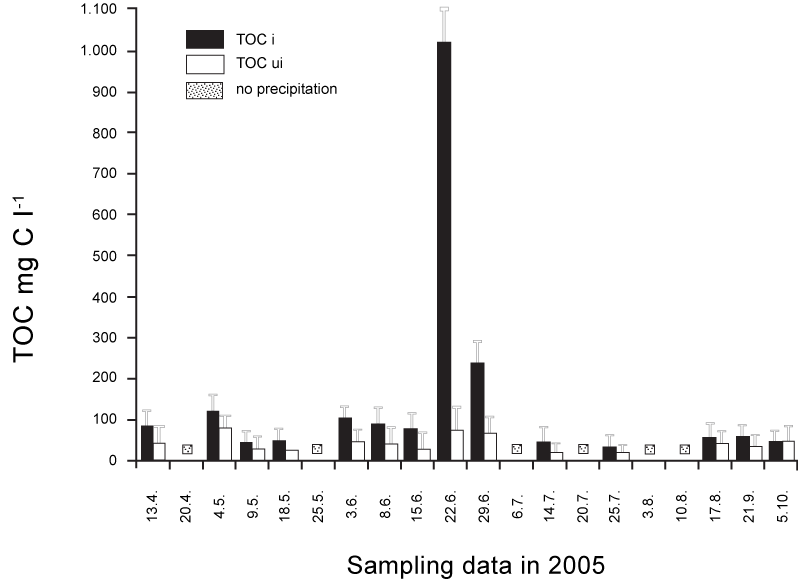 |
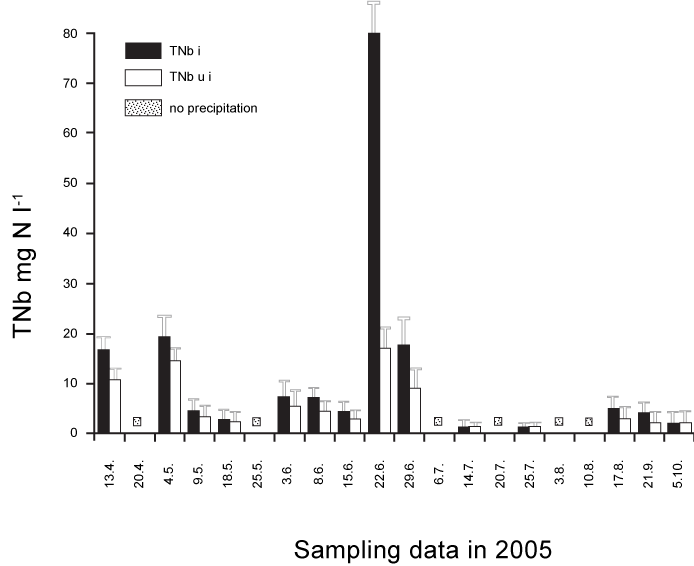 |
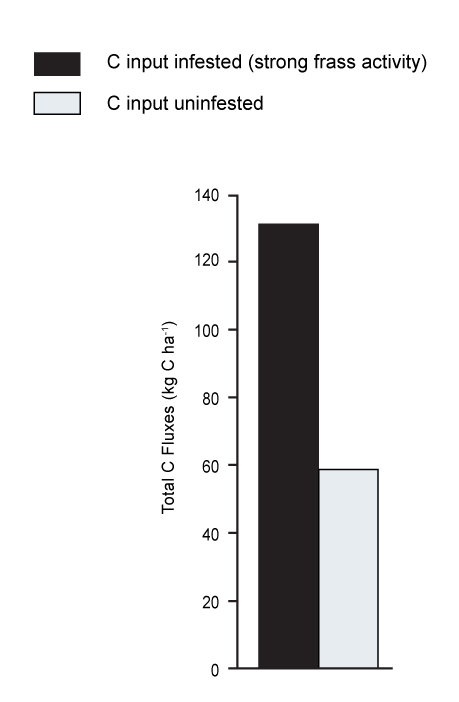 |
| Figure 1 | Figure 2 | Figure 3 |
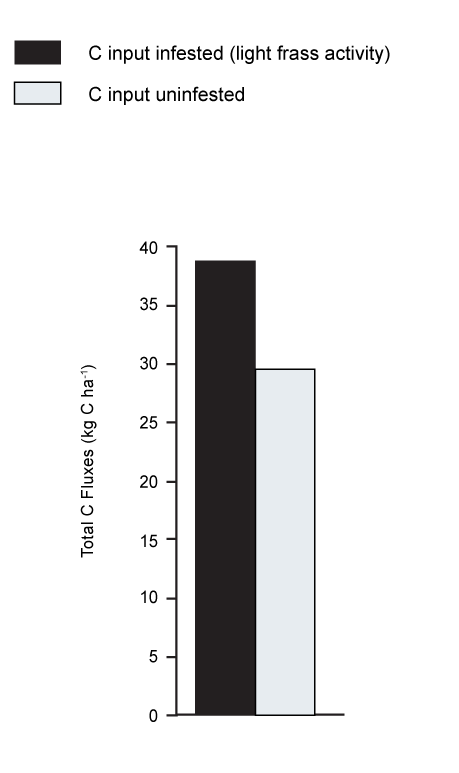 |
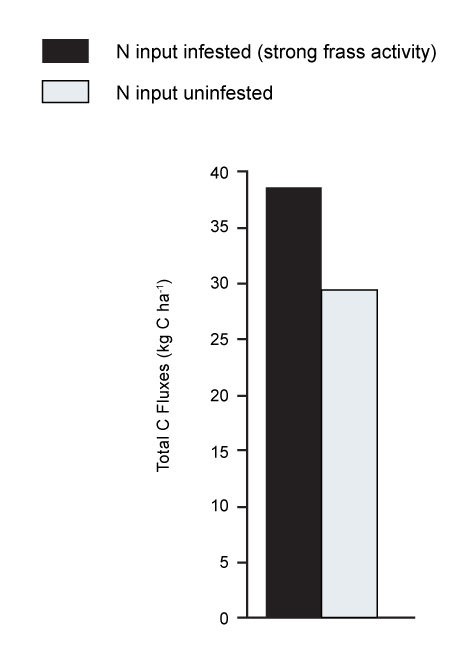 |
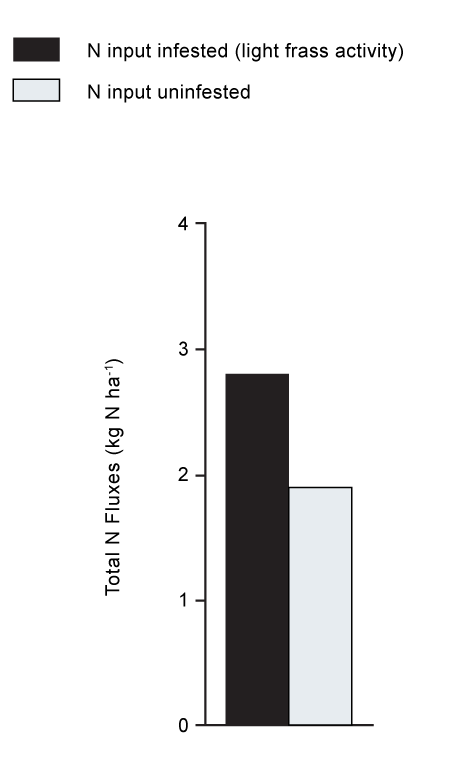 |
| Figure 4 | Figure 5 | Figure 6 |
Relevant Topics
- Atmosphere
- Atmospheric Chemistry
- Atmospheric inversions
- Biosphere
- Chemical Oceanography
- Climate Modeling
- Crystallography
- Disaster Science
- Earth Science
- Ecology
- Environmental Degradation
- Gemology
- Geochemistry
- Geochronology
- Geomicrobiology
- Geomorphology
- Geosciences
- Geostatistics
- Glaciology
- Microplastic Pollution
- Mineralogy
- Soil Erosion and Land Degradation
Recommended Journals
Article Tools
Article Usage
- Total views: 15994
- [From(publication date):
December-2010 - Apr 03, 2025] - Breakdown by view type
- HTML page views : 11421
- PDF downloads : 4573
